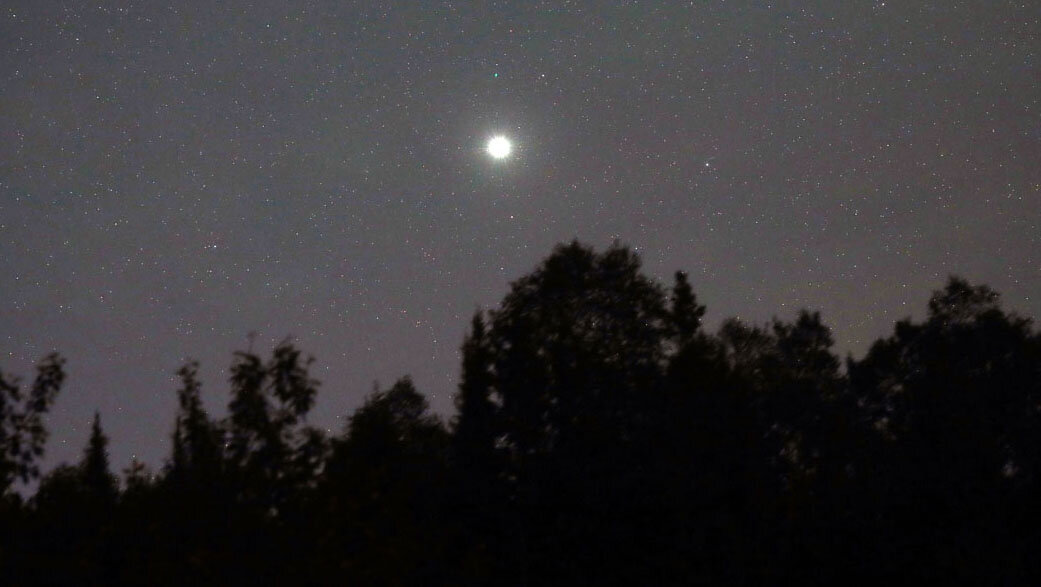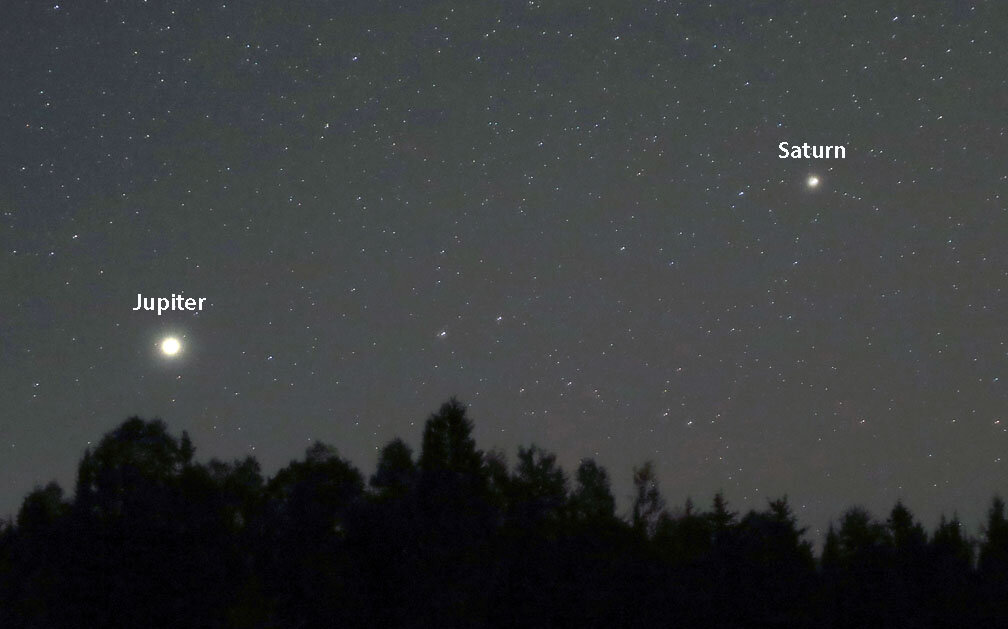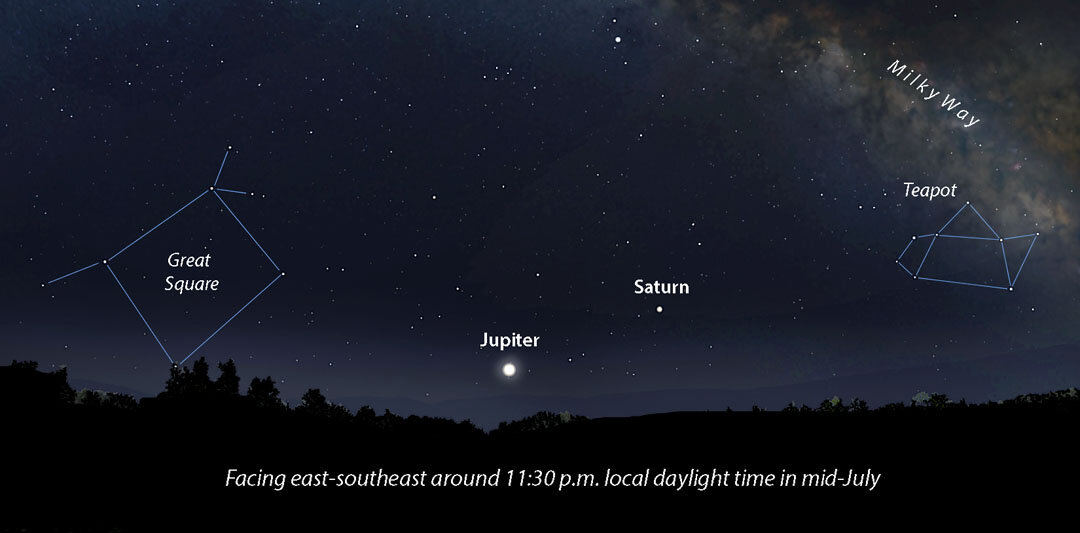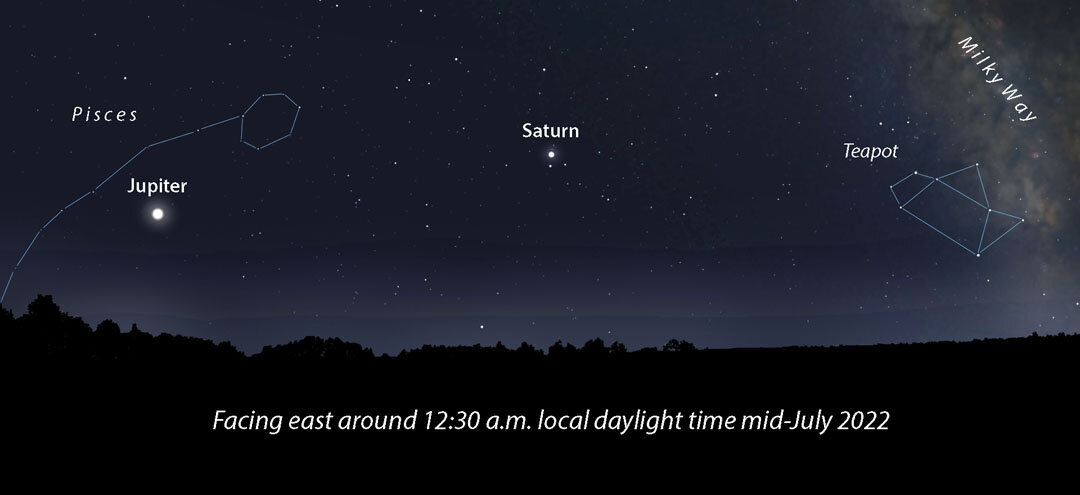What's That Bright Star in the East at Midnight?
Courtesy of Bob King (Astro Bob) and the Duluth News Tribune
Jupiter dominates the southeastern sky when it rises above the tree line around 11:30 p.m. in mid-July. This photo was taken around midnight July 8, 2021. Bob King
Someone asked on Facebook the other day about seeing a big, bright thing in the eastern sky late at night. Had to be Jupiter, I thought. Although Venus is the brightest planet, it's very low in the northwestern sky at dusk and not so obvious. You have to deliberately look for it. Jupiter, on the other hand, shines prominently in a dark sky.
I had the pleasure of seeing it rise almost in tandem with Saturn several nights ago before wildfire haze choked off much of the summer starlight. I can vouch for that Facebook user — Jupiter looks really bright! All the more so because it's in Aquarius, a faint constellation with no bright stars. Context counts. With no competition, Jupiter appears that much brighter.
Jupiter and Saturn are still paired up, but not as closely as last year and in reverse order, with Saturn leading. Bob King
In fact, the only bright object near Jupiter is Saturn, located two fists (20 degrees) to the right in Capricornus the Sea-goat. Last year, Jupiter preceded Saturn in the sky, but one year later the situation is reversed. Saturn rises first followed by Jupiter. That might make you think Saturn is the faster planet, "ahead" of Jupiter as it were. But it's actually the one that's been left behind.
Jupiter and Saturn are located midway between the Great Square of Pegasus and the Teapot of Sagittarius, both of which are bright asterisms. Stellarium
Except around the time of opposition, when the Earth and an outer planet are closest, Jupiter and Saturn move eastward — to the left as you face south — as they orbit the sun. Jupiter moves faster because it's closer to the sun. Seven months ago it passed the Saturn during their memorable Great Conjunction.
On July 13, Jupiter's on the go at 30,162 mph (48,541 kilometers per hour) compared to Saturn's more sluggish 20,611 mph (33,171 kph). The big planet passes through one zodiac constellation per year, while slower, more distant Saturn takes about two.
To keep track of the planets, start with the bright outer planets because they're easy to see at night. Jupiter and Saturn are perfect because they're still close enough together that you can watch them continue to separate in the next few years. Jupiter will always be the brighter one, and Saturn the slower one. Once you know those simple facts, go out the next clear night and find the two.
In mid-July, Saturn is first visible low in the southeastern sky around 10:45 p.m. local daylight time. Jupiter clears the trees closer to 11:30 p.m. I know those times are late for some, especially children. If so, wait a couple weeks and they'll be up earlier. Each day, the stars and planets rise 4 minutes earlier. That interval of time translates to 1° of motion, so stars drift westward 1 degree per day.
Each day, stars and planets in the eastern sky rise four minutes earlier. This example shows Jupiter on July 13 touching the trees at 11:52 p.m. One night later at the same time, it's a full degree higher. Stellarium
What magic is this? No magic at all. "Just celestial mechanics, ma'am," as Joe Friday from the TV show "Dragnet" might say. Earth's motion around the sun is the cause. Each day, as the Earth zips eastward in its orbit, stars in the east scooch higher. To make room for them, stars in the west advance closer to the western horizon. This slow sliding of the stars across the seasons and year is called seasonal drift.
What does it mean for you? If you see Jupiter tonight at 11:30 p.m. you'll see it in the exact same spot at 11:02 p.m. one week later. Do the math: 7 days x 4 minutes = 28 minutes. After three weeks it rises nearly an hour and a half earlier. All of this demonstrates the importance of patience in the pursuit of astronomy. If you don't want to get up late, you'll have to wait for the Earth to deliver the planets and favorite stars to you at a more convenient hour. We can't help but be bound to the rhythms of the cosmos.
In the coming weeks, Jupiter and Saturn will slowly drift to the west. Three months from now, they'll appear at their high point in the southern sky around 8:30 in the evening. Next year, in July 2022, you can look for them again. Saturn will have moved from central Capricornus to the constellation's eastern border and rise almost an hour later.
Speed demon Jupiter, meanwhile, will have left Aquarius in the dust and shine from Pisces, the next constellation to the east. It also will about an hour later than it does now. Amazingly, the distance between the two planets will be 44 degrees, more than double what it is now.
Faster Jupiter continues to distance itself from Saturn in the coming years. In July 2022, the planet will appear in Pisces the Fish 44 degrees to the east of Saturn. Jupiter won't pass Saturn again until 2040. Stellarium
Watching season to season and year to year you'll soon get a feel for the rhythm of each body and the seasonal drift of the stars. Instead of the solar system as a concept in a book or on a computer screen, it'll be in your bones.





